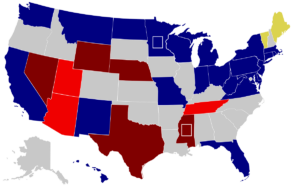The Blue Wave That Never Was
The media and the left would have us believe there is an unstoppable “Blue Wave” coming this November. In fact, the Democrats are on the defensive this year. The left could paint this election more honestly: a desperate fight to maintain Democrat minorities in both houses. Instead, they choose to talk up the coming blue wave as the inevitable result, which only seems to be exciting right wing voters. The races of the 2018 midterms could not be better for the GOP if they had been hand-picked. Ten Democrat Senators are defending seats in states that Trump won in 2016. Meanwhile, the GOP is defending three seats in friendly states. In the House over fifty Republicans and Democrats are retiring, more Republicans than Democrats, but again most of these districts are friendly to the GOP. From where are we to expect this “Blue Wave?” Basically, it would take a real “Blue Wave” to prevent a red one.
The 2018 Senate Map

Daily Kos Blog
The Democrats are defending 10 Senate seats in states won by Donald Trump in 2016. Trump won by double digits in five of these states : Indiana, Missouri, Montana, North Dakota, and West Virginia. In Ohio, Trump won by about 9%, and in four more states Trump won more narrowly (Florida, Michigan, Pennsylvania, and Wisconsin). Both Senate seats are up for election in Minnesota thanks to Al Franken’s resignation over sexual assault allegations. That makes 12 seats the Democrats must fight to defend.
The GOP, on the other hand, has only to defend nine seats, only three of which are competitive. In Arizona and Tennessee incumbents Jeff Flake and Bob Corker respectively have retired, but these are both safe red states and will likely remain in the GOP column. In Nevada incumbent Senator Dean Heller is seeking reelection in a state where Secretary Clinton won two years ago by less than 2.5%. In order to win a majority of the Senate, the Democrats would need to defend all twelve vulnerable seats and gain two of the GOP seats, a feat only a magician could accomplish. Meanwhile the GOP’s chances of gaining seats and broadening its Senate majority appear strong.
In Florida, where Trump won narrowly in 2016, incumbent Democrat Bill Nelson is facing a strong challenge from Governor Rick Scott. There was a concern about how Puerto Rican refugees might impact the election, since as citizens they already possess the right to vote. Governor Scott recently called for Puerto Rican statehood and this may have drawn more of these voters to his banner. In at least one recent poll, Scott had a 5% lead and a growing number of Florida insiders of both parties are skeptical of Nelson’s chances at reelection.
Midterm elections tend to have lower voter turnout than presidential elections. This lower turnout tends to favour the right. Nevertheless, one concern that has been raised is possible voter apathy on the part of right leaning voters. In recent primaries in Indiana, Ohio, and West Virginia, all states where Democrat incumbents are embattled, GOP primary turnout was higher than in the 2014 primaries. These results seem to indicate that Republican voters are not especially apathetic. Democrat primary turnout was higher too, but by a margin that is a fraction that of the GOP. It would seem Republican voters are interested in the midterms, are engaged and attentive, and plan to make themselves heard in November. If they do and in numbers, they could change the balance of power in Congress considerably.
The 2018 House of Representatives Map

270towin
In the House there are 35 seats where GOP incumbents are not seeking reelection, but even there, most are going to be comfortable wins for the GOP. Also retiring are 17 Democrats. All told, almost 12% of the House of Representatives will be made up of new representatives in 2019. The Democrats would have to gain twenty seats to hold a majority. With so many GOP incumbents leaving office it is likely the Democrats will gain a few seats here and there. Congressman Darrel Issa, for example, only narrowly won reelection in 2016 in his north San Diego district. The GOP will have to fight an uphill battle to retain that seat. Where else might they make gains? Due to a court ordered redistricting in Pennsylvania three Republican seats and one Democrat seat are in question. Seven more GOP seats are seriously in doubt, Arizona’s 2nd, Florida’s 27th, Michigan’s 11th, New Jersey’s 2nd and 11th, Ohio’s 12th, and Washington’s 8th. In total there are twelve GOP seats in serious contention, not enough to turn the House to the Democrats. Meanwhile, the Dems also have seventeen retiring representatives and in a handful of those seats the GOP may have a chance to make gains. These vulnerable seats include Arizona’s 1st, Minnesota’s 1st and 8th, New Hampshire’s 1st, and Nevada’s 3rd are also in play; plus at least one recently hard won special election victory in Pennsylvania. Eighteen GOP incumbents who are running for reelection will face tight races this year, but these Representatives will likely pull through. The GOP majority in the House is thus fairly safe.
Minnesota is a particular challenge for the Democrats this year. It was one of the states that saw a significant increase in GOP votes for Trump, albeit not enough. The governorship, a Senate seat, and two US House seats are in play there. The GOP could claim some serious ground in Minnesota if right wing voters turn out and the right candidates are nominated.
The Blue Burden
It would take a substantial “blue wave” just to sustain the status quo. Again, the GOP could not have hand picked better races for this year. The Democrats have built their campaign thus far on the basis that Trump is unpopular and they believe they can ride the wave of his unpopularity into majorities in the House and Senate. Even if that were true nationally, it is largely over red states and districts where the battles will be fought this midterm. Trump is not unpopular in these states and districts. The tax cut bill passed December last, is also popular in red states. Not one Democrat voted in favour of the tax cut bill. Democrat incumbents in dark red states are in deep trouble.
Could the Dems take another approach to this election? Perhaps by downplaying the midterms and downplaying expectations they might cushion the blow. One approach might be to paint this election as it is: a desperate fight to maintain Democrat minorities in both houses. This might drive up the interest of left wing voters, assist with fundraising, and increase voter turnout. Instead, the approach of talking up the coming blue wave is exciting right wing voters.
A Red Wave?

Image Courtesy Red State.com
The fact that President Trump’s approval numbers are up and there have been several major foreign policy victories will certainly give the GOP an advantage. Unemployment is at 3.9% (near target unemployment), the markets are up, and there is growing optimism. These are not the signs of a blue wave, they may indicate quite the opposite effect.







